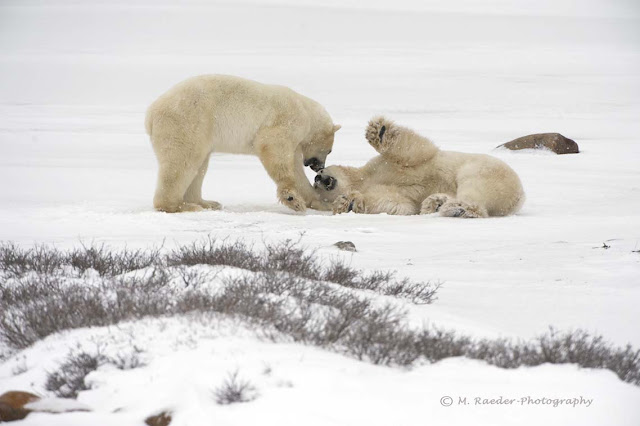Survival on the Arctic Ice
A tender moment
As many of you know, last November I traveled to Northern Canada to see and photograph the polar bears. After flying to Winnipeg and then up to Churchill, Manitoba, at the edge of the Hudson Bay I joined a group of photographers and we transferred out onto the ice to the Tundra Buggies where I stayed for 5 days living on the ice. The 2 hour journey from the tiny town of Churchill to the Tundra Lodge gave us a first impression of the barren land, the cold and the emptiness of the arctic. We welcomed reaching the warmth of the Tundra Lodge in the midst of this frozen country.

Tundra Buggy Lodge
Each morning we bundled up in big parkas, packed our photo gear, and went out in one of the movable tundra buggies into the white world in search for the polar bears. Driving slowly on frozen dirt roads with lots of potholes, cracking through the ice of frozen over puddles, our eyes glued to the landscape until we saw them: A mother and her ~8months old cubs!!
 |
Mother and her cubs (about 8 months old)
Churchill is known as the polar bear capital since the bears congregate there and wait for the Hudson Bay to freeze over. What a joy to observe this massive and said to be ferocious animal being so tender with her cubs. She shields the wind, gives them warmth in this unforgiving landscape as they wait for the ice to freeze over. Polar bears hunt for food on the ice, their diet consisting predominantly of seals.
Polar bears are on land during the arctic summer in a ‘summer hibernation’ living on their fat reserves from the winter until the next season. During that time, pregnant females den to give birth to their young. The mother lives on the fat reserves from the winter hunt not eating for 6-8 months and yet nursing her cubs.

Huddling for warmth with Mom

Playful young male polar bears

Play-fight between two young male polar bears

Adult male polar bear
Each fall, they wait for the ice to form to go north to feast mostly on seals and sometimes on other marine mammals like walruses. Unfortunately, their window of hunting and building up the fat reserves for the summer without any food has become shorter. Scientists have recorded that the ice forms about 1-2 months later in the Fall and melts earlier in the Spring, thus making the polar bear hungrier and vulnerable to starving. Recording the body weight of the Hudson polar bear population shows that there is a steady reduction in winter body weight. With this, the number of cubs in a litter has been going down. When 2-3 cubs were the norm historically, now only 1-2 cubs are being born and even with the reduced number of cubs, the mother bear has a hard time to feed them properly. Furthermore, the shrinking ice adds hardship to the winter conditions for the polar bears, specifically the young cubs. Polar bears are good swimmers but they hunt for seals from the ice and use the ice for resting. Since their young are still growing during their first winter, it is utmost important that the distance between floating ice is not too great. Even for adult bears, the greater distance between hunting grounds has lead to severe malnutrition and even starvation. Due to global warming and the changing ice conditions, drowning of polar bear cubs has been reported.

Male polar bear, searching for any food after the long summer hibernation
By monitoring the arctic ice cap over the last 30+ years, scientists have documented the shrinking of the arctic ice cap as can be seen on the next image (Ref: National Wildlife Federation). It shows (yellow line) the extent of the summer ice ~30 years ago and the current summer ice coverage which is about 39% below the long-term average measured since 1979. Both the walrus and the polar bear have become iconic symbols of the effects of global warming as the dwindling Arctic ice threatens their survival. If current warming trends continue unabated, scientists believe that polar bears will be vulnerable to extinction within the next century. Although climate change has greatly affected the polar bear’s sea ice habitat, scientists emphasize that it’s not too late to take action on this issue—and each of us can do our part: at home, work, and in our communities.
No hunting ground here!
...and hardly enough space to rest.
Here are some tips for how we all can help reducing our carbon footprint and helping the polar bears:
Reduce, Reuse, Recycle
Reduce: the less we consume, the less resources we use. Things like buying less products or purchasing products with less packaging, using less energy, and driving less are all things that reduce our eco-footprint.
Reuse: In addition to reducing our consumption, we can save energy by reusing products. This not only helps keep goods out of landfills, but reduces the need to manufacture more (thus creating more CO2), our disposable society isn’t good for the health of the planet, and an unhealthy planet affects us, too.
Recycle: So many things can be recycled these days and made into other things – it’s amazing! Even things like batteries, paint and electronics can be disposed of in proper facilities where they will separate out what can be recycled. So once you have reduced what you use and have reused what you can, all that’s left is to recycle the rest.
[Adapted from Polar Bear International ]









